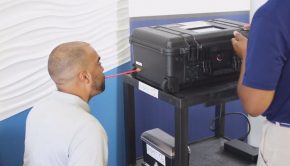COVID-19: How the virus spreads
Published on September 21st, 2020
While Scuttlebutt is far from an authority on COVID-19, it has impacted our sport (and everything else), so we seek to keep up on new information regarding the disease. However, much like everything to do with this coronavirus, there are hits and misses, such as the latest update from the US Centers for Disease Control and Prevention.
When it went online on September 18, apparently somebody pushed the button too quickly as it was only a draft version of proposed changes to their recommendations, and was posted in error to the agency’s official website.
But CDC is currently updating its recommendations regarding airborne transmission of SARS-CoV-2 (the virus that causes COVID-19). Once this process has been completed, the update language will be posted online… again.
The CDC has revised their information on September 21, but below are the highlights of what was posted in error on September 18, 2020:
COVID-19 is thought to spread mainly through close contact from person to person, including between people who are physically near each other (within about 6 feet). People who are infected but do not show symptoms can spread the virus to others. We are still learning about how the virus spreads and the severity of illness it causes.
COVID-19 most commonly spreads
• Between people who are in close contact with one another (within about 6 feet).
• Through respiratory droplets or small particles, such as those in aerosols, produced when an infected person coughs, sneezes, sings, talks, or breathes.
— These particles can be inhaled into the nose, mouth, airways, and lungs and cause infection. This is thought to be the main way the virus spreads.
— Droplets can also land on surfaces and objects and be transferred by touch. A person may get COVID-19 by touching the surface or object that has the virus on it and then touching their own mouth, nose, or eyes. Spread from touching surfaces is not thought to be the main way the virus spreads.
• It is possible that COVID-19 may spread through the droplets and airborne particles that are formed when a person who has COVID-19 coughs, sneezes, sings, talks, or breathes. There is growing evidence that droplets and airborne particles can remain suspended in the air and be breathed in by others, and travel distances beyond 6 feet (for example, during choir practice, in restaurants, or in fitness classes). In general, indoor environments without good ventilation increase this risk.
COVID-19 spreads very easily from person to person
How easily a virus spreads from person to person can vary. Airborne viruses, including COVID-19, are among the most contagious and easily spread. Some viruses are highly contagious, like measles, while other viruses do not spread as easily. The virus that causes COVID-19 appears to spread more efficiently than influenza, but not as efficiently as measles, which is highly contagious. In general, the more closely a person with COVID-19 interacts with others and the longer that interaction, the higher the risk of COVID-19 spread.
Complete update… click here.









 We’ll keep your information safe.
We’ll keep your information safe.